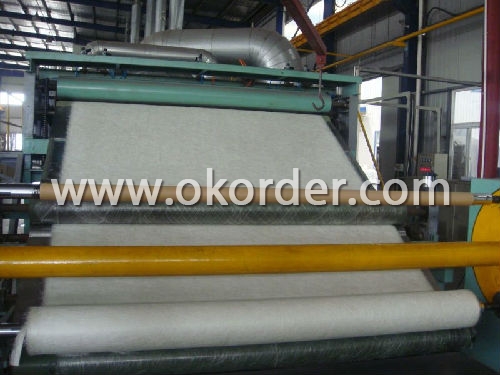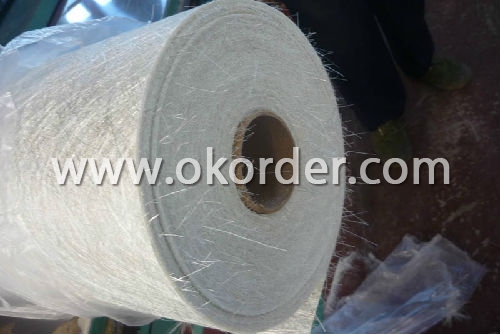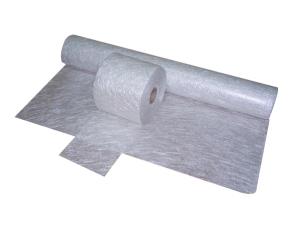C-glass CSM
- Loading Port:
- China Main Port
- Payment Terms:
- TT or LC
- Min Order Qty:
- 5Ton kg
- Supply Capability:
- 600TON PER MONTH kg/month
OKorder Service Pledge
OKorder Financial Service
You Might Also Like
Feature of C-glass CSM
high dry ,wet tensile strength ,good transparency
Appliction of C-glass CSM
various panels, boats, bath equipment automotive parts
we are one of the professional factory who can manufacture chopped strand mat well in China.
Fiberglass Chopped Strand Mat is an unwoven fabric consisting of randomly distributed chopped strands held together with a powder or emulsion binder.
Chopped Strand Mat is compatible with unsaturated polyester, vinyl ester, epoxy and phenolic resins. This specification is most widely used in hand lay-up process and can also be used in filament winding, Compression molding and continuous laminating processes. The typical end-use applications include various panels, Tank, boat,stailgate of a truck ,etc
Specification of C-glass CSM
General Data:
Product Code: EMC,CMC
Glass type: E-glass,C-GLASS
Bond type: Powder binder or Emulsion binder
Desity: 100g/m2~ 900g/m2.
Roll Width: 200-3200mm usually is 1040mm/1250mm/1270mm
package of C-glass CSM
polythelene bag+carton+pallet+Stretch wrap film


- Q:How is fiberglass mat tissue used in the manufacturing of wind turbine blades?
- Fiberglass mat tissue is extensively used in the manufacturing of wind turbine blades due to its exceptional strength, durability, and lightweight properties. It serves as a critical reinforcement material that enhances the structural integrity and performance of the blades. During the manufacturing process, layers of fiberglass mat tissue are carefully placed and bonded together to form the composite structure of the wind turbine blade. The tissue layers are typically impregnated with a resin, such as epoxy or polyester, to create a strong and rigid matrix. The use of fiberglass mat tissue allows for the creation of complex blade shapes with high dimensional accuracy. It provides excellent resistance against various environmental factors, such as UV radiation, moisture, and temperature fluctuations, ensuring the longevity of the turbine blades in harsh weather conditions. The mat tissue also plays a crucial role in distributing and absorbing the loads experienced by the wind turbine blades. It enhances the overall strength and stiffness of the structure, allowing the blades to withstand the aerodynamic forces exerted by the wind. This reinforcement is particularly important to prevent blade deformation and fatigue, ensuring optimal performance and safety over the lifetime of the turbine. Moreover, the lightweight nature of fiberglass mat tissue contributes to the efficiency of wind turbine blades. The reduced weight of the composite structure enables the blades to rotate more easily and capture more energy from the wind. This, in turn, increases the power output and efficiency of the wind turbine system. Overall, fiberglass mat tissue is a fundamental component in the manufacturing of wind turbine blades, providing essential reinforcement, durability, and lightweight properties. Its use significantly contributes to the performance, reliability, and sustainability of wind energy generation.
- Q:Can fiberglass mat tissue be used for insulation in cleanrooms?
- Fiberglass mat tissue can indeed be used for insulation in cleanrooms. It offers several advantages that make it a suitable choice for such applications. Firstly, fiberglass mat tissue has excellent thermal insulation properties, which helps to maintain the desired temperature and prevent heat transfer in cleanrooms. This is crucial in environments where temperature control is essential for processes or equipment. Additionally, fiberglass mat tissue has good acoustic insulation capabilities, which can help in reducing noise levels within cleanrooms. This is particularly important in cleanrooms where sensitive equipment or experiments are conducted, as minimizing noise disturbances can ensure accurate and reliable results. Furthermore, fiberglass mat tissue is non-combustible, meaning it does not catch fire easily. This adds an extra layer of safety in cleanrooms where flammable materials or volatile substances may be present. The non-combustible nature of fiberglass mat tissue also contributes to its overall durability and longevity. Lastly, fiberglass mat tissue is resistant to moisture, making it suitable for cleanrooms where humidity control is crucial. It does not absorb moisture, preventing the growth of mold or mildew, which can be detrimental to cleanroom environments. Overall, fiberglass mat tissue is a viable option for insulation in cleanrooms due to its thermal and acoustic insulation properties, non-combustible nature, and resistance to moisture. Its use can contribute to maintaining the desired conditions within cleanrooms and ensuring the integrity of processes and equipment.
- Q:Is fiberglass mat tissue suitable for insulation in data centers?
- Yes, fiberglass mat tissue is a suitable material for insulation in data centers. It provides excellent thermal insulation properties, helping to maintain the desired temperature and prevent heat loss. Additionally, fiberglass is fire-resistant and can offer acoustic insulation, reducing noise levels in the data center. Overall, fiberglass mat tissue is a reliable and effective choice for insulation in data centers.
- Q:How does the fiber content of fiberglass mat tissue affect its strength?
- The fiber content of fiberglass mat tissue directly affects its strength. A higher fiber content typically results in a stronger fiberglass mat tissue. The fibers provide reinforcement and structural integrity to the tissue, making it more resistant to breaking or tearing. Additionally, a higher fiber content enhances the overall durability and load-bearing capacity of the fiberglass mat tissue.
- Q:Is fiberglass mat tissue resistant to pests and insects?
- Pests and insects usually find fiberglass mat tissue to be non-resistant. Although pests do not consider fiberglass itself as a source of food, they may be attracted to the binders and resins utilized during manufacturing. Furthermore, pests can gain access through tiny cracks or openings in the fiberglass. Nevertheless, it is possible to enhance the resistance of fiberglass mat tissue against pests and insects by applying specialized chemicals or coatings. Consulting a professional or the manufacturer is advised to determine the most suitable method for achieving pest and insect resistance in fiberglass mat tissue.
- Q:What is the cost of fiberglass mat tissue?
- The cost of fiberglass mat tissue can vary depending on various factors such as the brand, quality, quantity, and location. On average, fiberglass mat tissue can range from $0.50 to $2 per square foot. However, it is important to note that prices may differ based on the specific needs of the project and the supplier or retailer from which it is purchased. It is recommended to research and compare prices from different sources to find the most suitable and cost-effective option for your requirements.
- Q:What is the composition of fiberglass mat tissue?
- Fiberglass mat tissue is typically composed of fine strands of glass fibers that are woven or matted together to form a thin, flexible sheet. These glass fibers are made from molten glass that is drawn into thin filaments and then bundled together to create the desired thickness and density of the mat tissue. The glass fibers are often coated or treated with a binder material to enhance their strength and adhesion properties.
- Q:What is the typical width of fiberglass mat tissue rolls?
- The typical width of fiberglass mat tissue rolls can vary depending on the specific manufacturer and intended application. However, in the construction and insulation industries, fiberglass mat tissue rolls are commonly available in widths ranging from 1.22 meters (4 feet) to 2.44 meters (8 feet). These dimensions are often chosen to align with standard building materials and construction practices. It is important to note that there may be variations in width options depending on the region or supplier, so it is advisable to consult with the manufacturer or supplier for the specific width requirements for a particular project.
- Q:What are the potential health and safety concerns associated with working with fiberglass mat tissue?
- There are several potential health and safety concerns when it comes to working with fiberglass mat tissue. First and foremost, the presence of tiny glass fibers in fiberglass means that they can become airborne when the material is cut, sanded, or disturbed. Inhaling these fibers can lead to respiratory problems like coughing, wheezing, and difficulty breathing. Prolonged exposure to fiberglass dust can also result in lung diseases such as fibrosis or even lung cancer. Furthermore, direct contact with fiberglass mat tissue can cause skin irritation, resulting in itching, redness, and rashes. The sharp glass fibers can also cause small cuts or punctures, which can lead to infection if not properly treated. In addition, fiberglass is a lightweight material that can easily become airborne and settle on surfaces. This increases the risk of ingestion or contamination of food and drinks. Swallowing fiberglass particles can irritate the digestive system, resulting in symptoms like nausea, vomiting, and abdominal pain. To ensure the well-being of workers, it is important to take proper precautions when working with fiberglass mat tissue. This includes wearing personal protective equipment such as gloves, safety glasses, and respiratory masks to minimize exposure to airborne fibers. Adequate ventilation and dust control measures should also be implemented to prevent the accumulation of fiberglass dust in the work area. Regular cleaning and maintenance should be carried out to keep the work environment free from fiberglass particles. Additionally, workers should receive education on the correct handling and disposal of fiberglass materials to minimize the risk of contamination. Overall, while fiberglass mat tissue is widely used, it is crucial to be aware of the potential health and safety concerns associated with its handling and to take necessary precautions to minimize the risk of exposure.
- Q:Can fiberglass mat tissue be used for ballistic protection?
- Fiberglass mat tissue can be used for ballistic protection to some extent, but it may not offer the same level of protection as other materials specifically designed for this purpose. Fiberglass mat tissue is typically used in applications such as insulation, reinforcement, and fire resistance due to its high strength and heat resistance properties. However, when it comes to ballistic protection, there are more specialized materials available that are specifically engineered to withstand the impact of bullets or other projectiles. These materials often include aramid fibers (such as Kevlar) or ultra-high-molecular-weight polyethylene fibers (such as Dyneema) which are much more effective in providing superior ballistic protection. If ballistic protection is the primary concern, it is recommended to choose materials specifically designed for this purpose rather than relying solely on fiberglass mat tissue.
1. Manufacturer Overview |
|
|---|---|
| Location | Zhejiang, China |
| Year Established | 1969 |
| Annual Output Value | Above US$ 150 Million |
| Main Markets | overseas companies in Hongkong, Canada, South Africa, South Korea, India, Italy, Singapore, France and many other countries and regions. |
| Company Certifications | ISO9001;ISO14001 |
2. Manufacturer Certificates |
|
|---|---|
| a) Certification Name | |
| Range | |
| Reference | |
| Validity Period | |
3. Manufacturer Capability |
|
|---|---|
| a)Trade Capacity | |
| Nearest Port | Shanghai |
| Export Percentage | 40%-50% |
| No.of Employees in Trade Department | 21-50 People |
| Language Spoken: | English |
| b)Factory Information | |
| Factory Size: | Above 5000,000 square meters |
| No. of Production Lines | Above 5 |
| Contract Manufacturing | |
| Product Price Range | Average |
Send your message to us
C-glass CSM
- Loading Port:
- China Main Port
- Payment Terms:
- TT or LC
- Min Order Qty:
- 5Ton kg
- Supply Capability:
- 600TON PER MONTH kg/month
OKorder Service Pledge
OKorder Financial Service
Similar products
New products
Hot products
Hot Searches
Related keywords





























